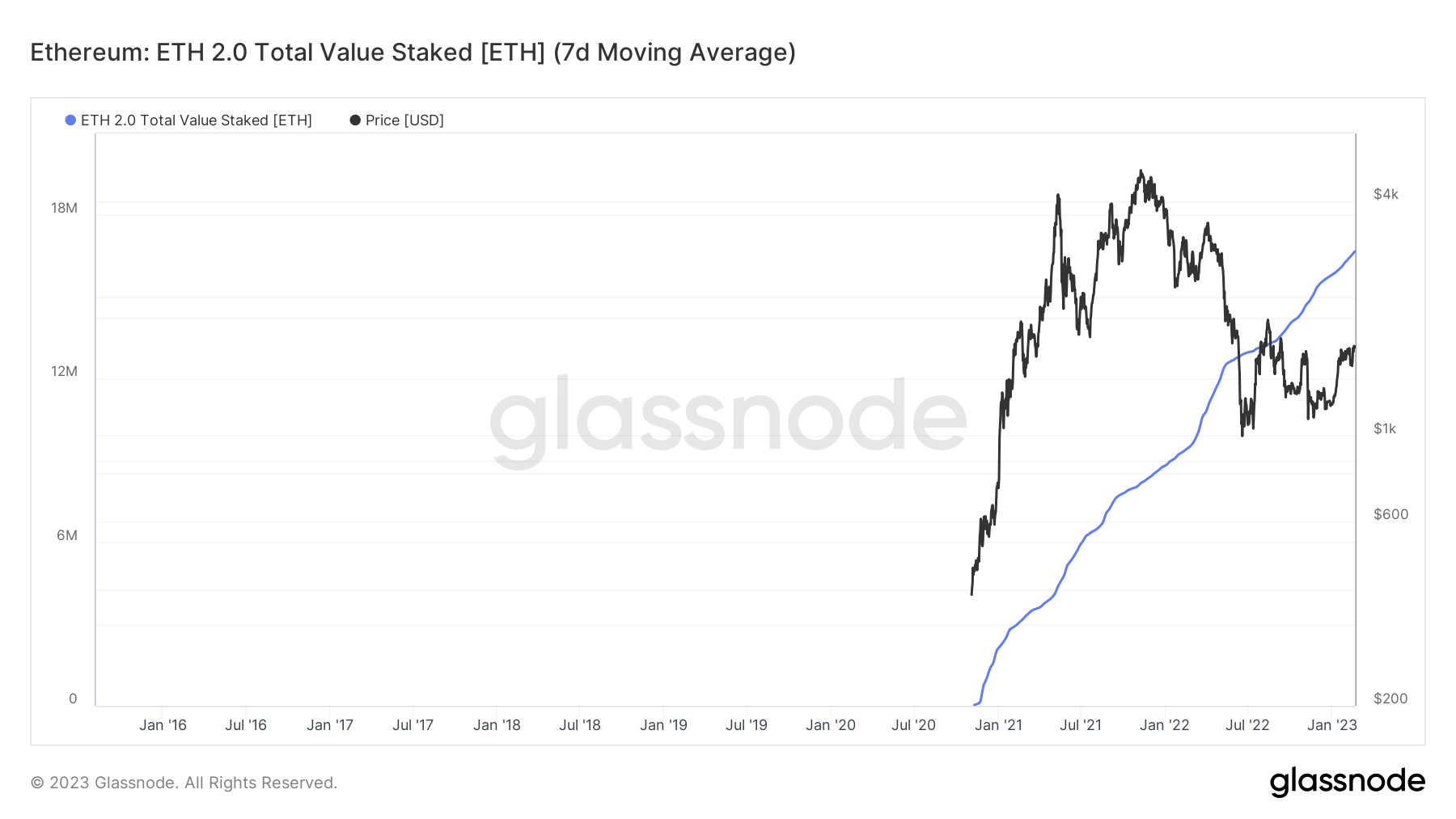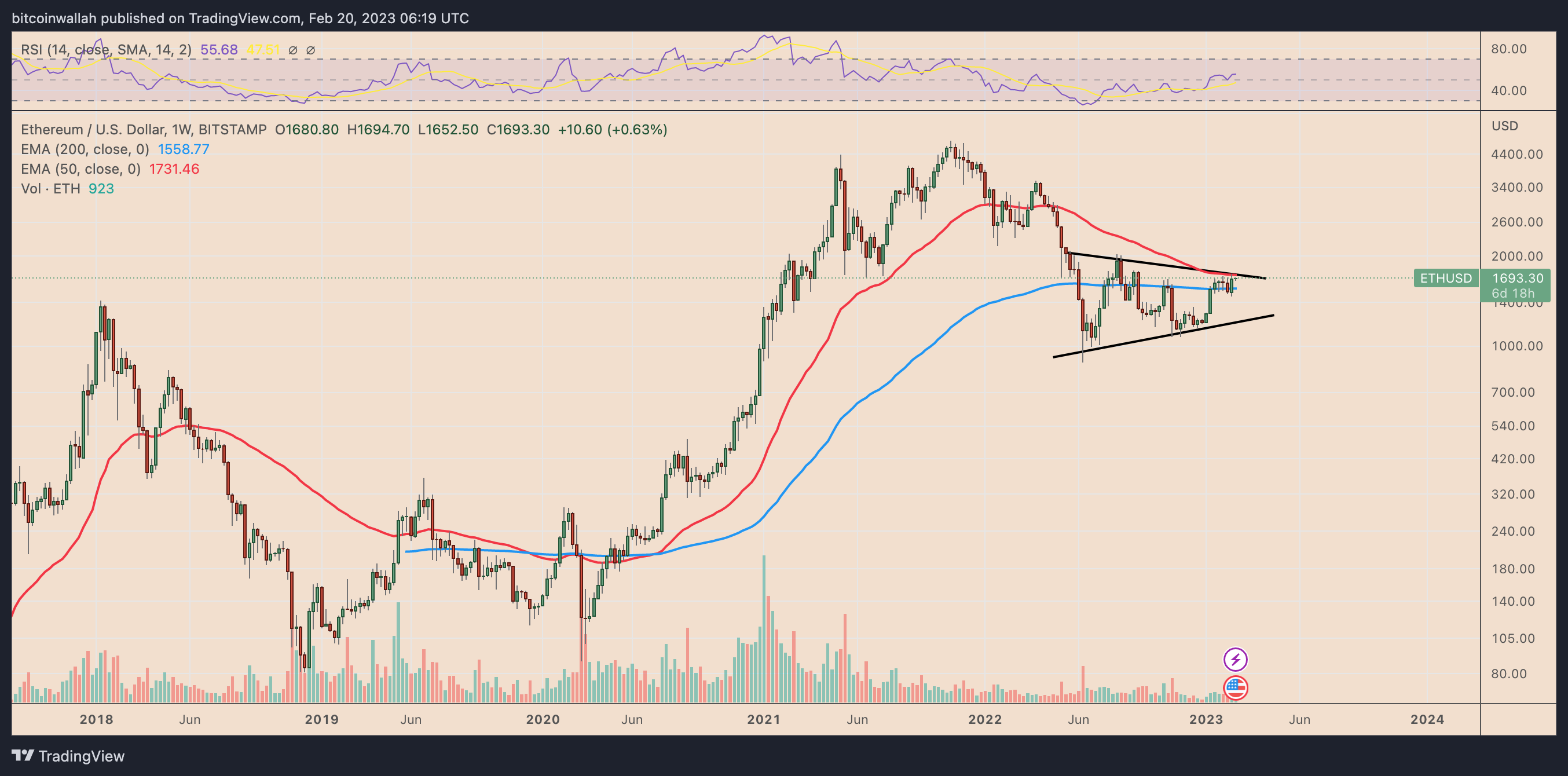
Ethereum’s deflation accelerates as Shanghai upgrade looms — Can ETH price avoid a 30% drop?

A deflationary Ethereum supply does not necessarily mean a bullish market for ETH, at least in the near term.
The price of Ethereum’s native token, Ether (ETH), has surged by more than 40% year-to-date to around $1,750, the highest level in seven months. However, ETH price is not out of the woods yet despite several bullish cues such as the Shanghai upgrade in the pipeline.
Ethereum price bull trap?
Ether’s rise has appeared primarily in the wake of similar upside moves elsewhere in the crypto market, responding to lowering inflation that reduces the Federal Reserve’s likelihood of raising interest rates aggressively.
At the same time, warnings about an imminent bull trap in the risky markets have emerged, which may wipe out their recent profits. Ethereu, due to its long-term correlation with stocks and Bitcoin, faces similar risks.
Bull Trap About to confirm on $ETH and $BTC along with shooting stars on both. Failed breaks usually trigger the biggest opposing moves. You have been warned. If stocks do dump, reversal signal on crypto can follow. Close > that shooting star candle invalidates the trap. pic.twitter.com/tJ9c5N0M3J
— Cameron Fous (@Cameronfous) February 16, 2023
Let’s take a closer look at several potential bullish and bearish catalysts for the price of Ethereum below.
ETH becomes most deflationary since Merge
The issuance rate of Ether has dropped to its lowest level since the network’s transition to Proof-of-Stake (PoS) via “the Merge” in September.
On Feb. 20, Ether’s annual supply since the Merge shrunk to -0.056%. In other words, the Ethereum network had been minting fewer ETH tokens than were removed from the supply in the past five months.

Investors typically perceive a cryptocurrency with a fixed supply or deflationary issuance rate as bullish in the longer term.
#Ethereum‘s #deflation #rate is accelerating by the day. This has very positive impact on the supply/demand dynamics, and should send the price a lot higher as demand increases. I think this is happening very soon. #ETH #ETHE pic.twitter.com/dnHVKBabuf
— Jesse Dow (@JesseLeeDow1) February 16, 2023
Ethereum’s supply is currently around 120.50 million, but there is technically no max supply. The London hard fork in August 2021, however, introduced a fee-burning mechanism that added deflationary properties to Ether’s tokenomics.
As a result of this upgrade, the higher the Ethereum network’s transaction fees at any given time, the more Ether will be “burned” or removed from the supply forever.
Interestingly, Ethereum’s median gas price has rebounded to a seven-month high of 27.13 Gwei (the smallest ETH unit) in the week ending Feb. 17.

Shanghai hard fork
ETH demand must not drop against a deflationary supply rate for the price to climb. One potential bullish catalyst in the pipeline for Ethereum is its upcoming network upgrade dubbed Shanghai, slated for mid-March.
The Shanghai hard fork enables users who have locked their Ether into Ethereum’s PoS smart contract to withdraw their assets finally. This increased liquidity could encourage more people to hold and stake Ether tokens, according to Kennan Mell, an independent market analyst.
In his SeekingAlpha note, Mell argues:
“It’s possible that the successful implementation of staking withdrawals will boost Ethereum’s price as new investors decide to buy in right afterward, either because they were waiting to buy until the network successfully went through a risky hard fork to implement withdrawals or because they are lured by a more liquid staking yield.”
Meanwhile, the total value locked in the Ethereum PoS contract continues to rise to new record highs, with the latest data showing deposits worth nearly 16.63 million ETH.

Crypto staking crackdown
The above-mentioned potential bullish catalysts for ETH price, however, could be offset by regulatory crackdowns and unfavorable technicals in the near term.
In February, the United States Securities and Exchange Commission (SEC) fined Kraken, a popular crypto exchange, $30 million for not registering its staking-as-a-service program, which includes the option of Ethereum staking.
Related: Ethereum’s Shanghai fork is coming, but it doesn’t mean investors should dump ETH
Coinbase exchange CEO Brian Armstrong also warned that the SEC might ban crypto staking services for retail investors altogether. If true, such a prohibition could hurt Ether’s demand among U.S. investors.
Resembles poor financial advice to diversify into stocks in an economy of high FFR and inflation
But, SEC wanting to ban staking is valid
Major exchanges like #Binance can no longer offer in-app staking
AND
PoS protocols like #Ethereum will be subject to security laws & taxes https://t.co/1YxpVNxD0B
— oracledaddy (@oracIedaddy) February 20, 2023
ETH price hits bearish inflection level
From a technical perspective, Ether price is currently testing a key resistance confluence for a potential pullback.
Notably, the confluence comprises a multi-month descending trendline resistance and a 50-week exponential moving average (50-week EMA; the red wave), as shown below.

A pullback from the confluence could have ETH’s price test the 200-week EMA (the blue wave) near $1,550 as its short-term downside target.
Furthermore, an extended correction could push the price toward the black ascending trendline support near $1,200 by March 2023, down about 30% from the current levels.
Conversely, a decisive breakout above the descending trendline resistance could activate a bullish reversal setup toward the $2,000-$2,500 area.
This article does not contain investment advice or recommendations. Every investment and trading move involves risk, and readers should conduct their own research when making a decision.
Go to Source
Author: Yashu Gola









